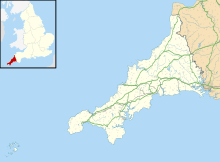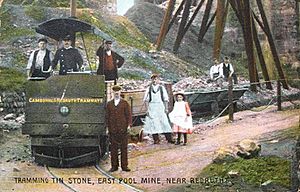East Pool mine facts for kids

The engine house and stack at Taylor's Shaft
|
|
| Location | |
|---|---|
| Location | Redruth |
| Unitary | Cornwall |
| Country | UK |
| Coordinates | 50°13′52″N 5°15′44″W / 50.2312°N 5.2622°W |
| Production | |
| Products | Copper, tin, arsenic and wolframite |
| History | |
| Opened | early 18th century |
| Closed | 1945 |
| Owner | |
| Company | National Trust |
| Website | East Pool Mine |
| Official name: East Pool Mine | |
| Designated | 3 September 2004 |
| Reference no. | 1021323 |
|
Listed Building – Grade II*
|
|
| Official name: Pump engine house at Taylor's Shaft of New East Pool Mine | |
| Designated | 9 April 1975 |
| Reference no. | 1142600 |
|
Listed Building – Grade II*
|
|
| Official name: Chimney stack approx. 30 metres east of pump engine house at Taylor's Shaft of New East Pool Mine | |
| Designated | 9 April 1975 |
| Reference no. | 1328183 |
|
Listed Building – Grade II
|
|
| Official name: East Pool Mine Engine House | |
| Designated | 12 September 1989 |
| Reference no. | 1160518 |
East Pool mine (also known as East Pool and Agar mine) was a very important mine in Cornwall, England. It was located near the village of Pool, in the Camborne and Redruth mining area. People worked at this mine from the early 1700s until 1945.
At first, the miners dug for copper. Later, they focused on finding tin. The mine was very successful and made a lot of money for many years. Today, you can visit the site and see two old beam engines that have been saved. East Pool mine is now part of the Cornwall and West Devon Mining Landscape World Heritage Site, which means it's a special place recognized around the world. The National Trust takes care of the mine site.
Contents
What They Mined Here
The rocks found at East Pool mine are mostly a type called killas and greenstone. These rocks sit on top of a larger rock formation known as the Carn Brea granite. There are many mineral veins, called "lodes," running through the mine area. These lodes are also crossed by different rock layers called "elvan dykes."
The main things mined here were copper and later tin. Miners also found arsenic and wolframite. Small amounts of other valuable minerals like bismuth, cobalt, and uranium were also present.
Early Days of the Mine (Before 1900)
East Pool mine began in the early 1700s. Back then, it was known as "Pool Old Bal" and was a copper mine. The land where they mined was rented from the Basset family. The money earned from the mine helped this family build their large country home at Tehidy.
Miners dug a tunnel called an adit about 32 fathoms (about 58 meters) underground. They also dug even deeper, about 16 fathoms (about 29 meters) below the adit. Water was removed from these deep areas using a system of rods powered by a water wheel. This early mining stopped in 1784.
The mine reopened in 1834 and was named East Pool mine. It was a small mining area, about 900 by 400 yards. It was next to other mines like South Crofty and Tincroft mines. To its north was Wheal Agar, which it later joined with.
East Pool mine was very productive for a long time. It produced about 91,000 long tons of copper ore and later 46,000 long tons of tin ore. In its early years, the copper ore was very rich. In 1835, it sold for more than double the average price. This profitable period lasted for ten years, and the mine paid out a lot of money to its owners.
By 1843, about 300 people worked at the mine. The deepest parts were about 90 fathoms (about 165 meters) deep. However, in the late 1840s, mining became difficult. The mine almost closed, and its tunnels started to fill with water. This also put the nearby South Crofty mine at risk.
Because of this, Lady Basset, who owned the land, said she would take back the mining rights if the mine wasn't fully worked. East Pool mine struggled but kept going. It earned some money by charging nearby mines, including Wheal Agar, for draining water. It didn't become profitable again until 1854.
In 1860, miners found a rich amount of wolframite ore. This ore is similar to tin ore, so it was hard to separate them using normal methods. To solve this, they installed a special machine called a "Wetherill's Magnetic Separator." This machine could process 10 tons of ore every day.
East Pool was one of the few mines that survived a tough time for the Cornish mining industry in the late 1800s. Other mines that survived were South Crofty, Tincroft, and Dolcoath. All these mines were close together, and keeping water out was very important. If one mine's pumps stopped, it caused big problems for the others.
The problem with underground water was so bad that the mine's winding engines, which usually lifted ore, were changed to lift water instead. This happened at East Pool in 1897. East Pool also had a problem with water coming from Wheal Agar, which was losing money and kept threatening to turn off its pumps. Wheal Agar did turn off its pumps in late 1895. This caused the productive lower parts of East Pool to flood.
After more than a year of talks, and with help from Lord Robartes, East Pool bought Wheal Agar and all its equipment for £4,000. This happened on March 10, 1897.
East Pool After 1900
Even with its challenges, East Pool mine employed more than 500 people almost every year from 1884 to 1913. About half worked above ground, and half worked underground. In 1913, the mine changed from being run by a simple partnership to a larger company called East Pool and Agar Ltd.
Since the 1860s, the mine had a large plant for processing ore. This plant was about a mile east, in the Red River valley at Tolvaddon. From 1903 until 1934, ore was moved to the plant using a special tramway. This tramway used part of the old Camborne and Redruth Tramways track and went through Pool village.
After the tramway closed in 1934, the ore was carried by an aerial ropeway. This was like a cable car system that went directly across the countryside to the mill. This system worked well until the mine closed in 1945.
In 1921, there was a big rockfall underground. This destroyed both of the mine's main shafts, which caused flooding. So, in 1922, they started building a new shaft. They named it Taylor's Shaft, after the mine manager.
In 1924, a very large pumping engine was installed at Taylor's Shaft. This engine was 90 inches (about 2.3 meters) in diameter. It had been moved from Carn Brea mine, where it had not been used since 1914. This famous engine was known as Harvey's Engine. It was designed by Nicholas Trestrail and built in 1892 by Harvey & Co. It pumped water from the mine using seven sets of pumps.
The tall chimney stack for this engine's boilers was finished before the engine house was even built. This chimney is 110 feet (about 33.5 meters) tall. A special feature of this chimney is the white bricks near the top that spell out "EPAL" vertically. "EPAL" stood for "East Pool and Agar Limited." It was also the brand name for the arsenic that the company sold.
The mine was taken over by its neighbor, South Crofty, and closed in 1945. However, Harvey's Engine kept pumping water out of the South Crofty workings until September 28, 1954. Then, electric pumps took over. Harvey's Engine might have been thrown away if it wasn't for a man named Mr. Greville Bathe from Florida. He bought the engine and gave it to the Cornish Engines Preservation Committee. They then gave it to the National Trust in 1967.
East Pool Mine Today
Today, East Pool mine is part of the Cornwall and West Devon Mining Landscape World Heritage Site. Two large beam engines have been saved and can be seen here.
Michell's Shaft Engine House contains the last beam engine of its kind to be installed in Cornwall. This engine has a cylinder 30 inches (about 0.76 meters) wide. It was built in 1887 by Holman Brothers and cost £675. It was designed to run at 27 strokes per minute and could wind things up at 1,000 feet (about 305 meters) per minute. This engine was saved from being scrapped in 1941. The National Trust has cared for it since 1967, and it is still run sometimes for visitors.
At Taylor's Shaft, the National Trust has an Industrial Discovery Centre. This center includes several buildings from the 1920s. One of these buildings is the engine house that still holds the 90-inch Harvey's Engine. This engine was saved thanks to a generous gift from an American supporter.
Images for kids
See also
- Cornish steam engine
- Mining in Cornwall and Devon









